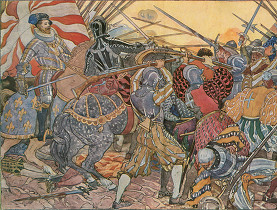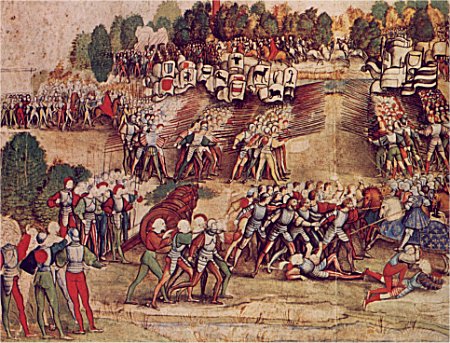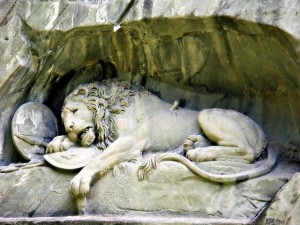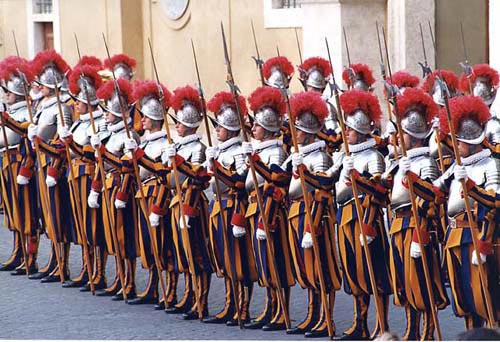By Theodore Jaspers

A histrionic illustration of victory for a regiment from the Swiss Canton of Glarus for France's Henry IV against the Spanish, in the battlefield of Arques, 1598.
Introduction
This guide serves to help researching the political and military workings of historical Switzerland, and gives resources that aid research in the area thereof. The Confœderatio Helvetica has maintained its republican style of governance through the centuries while its surrounding polities have statically shifted from one regime to another. The fact that Switzerland has sustained its political traditions and popular sovereignty makes it an interesting subject to research how this alpine, quadrilingual selection of semi-sovereign cantons has preserved its way of life and neutrality in the midst of a continent that has seen much warfare from many of its states. In historiography, the Swiss Confederation has often been regarded as an efficient, traditional republic that does not assume the role of the belligerent. Rather, it has aided many countries in wars through its military services for hire, which have been viewed in retrospect by many European heads of state as formidable. The Old Swiss Confederacy, founded in 1291 and expanded through time, was the basis for the confederation which exists now, and has maintained a form of political isolationism through the ages. This isolationism excludes the mercenary trade which Switzerland engaged in heavily, and which gave the cantons great benefits through foreign investment, the emergence of a structured society and military service and the efficiency which resulted from it, as well as an outlet of excess populace through participation in foreign military campaigns. Swiss soldiers, or “Reisläufer” have participated in, among others, the Burgundian Wars, the Napoleonic Wars, and their services have been made use of by the French, the Spanish, the Dutch, the Italian city states, the Vatican, and many other political entities from the Age of Enlightenment onward.
The sources, which consist of Web, Print and video sources, describe and focus on the background of Switzerland and the forming of it, to what it is now, in a context of continental politics and alliances. It is to be noted that Switzerland had no concrete political alliances (except during the battle of Marignano in 1515, in which the Confederacy supported the Duchy of Milan), but that there were economic agreements regarding the use of Swiss mercenaries between the Confederation and European powers. The authors and producers of these sources vary from historians familiar with the Swiss participation in warfare, to interpreters of Machiavelli’s writings, and also include the Vatican’s website.

The Battle of Marignano in 1515. The Swiss Confederation, allied to the Duchy of Milan, fought Francis I of France and the Republic of Venice, whose armies also included Swiss regiments.
Printed Sources:
- James Murray Luck, History of Switzerland (Society for the Promotion of Science and Scholarship, 1985)
This book is a good starting point for any research on the Confederation’s history, as the first half of the 800 page book describes the political and military events and alliances between Switzerland and its surrounding countries. This book creates a timeline in which the military commitments of the Swiss Cantonal mercenary services largely to The Netherlands, Spain, France and the Holy Roman Empire, are easily traced, and is put in a broad context of European history in general.
“The War Minister Marquis de Louois, said one day to king Louis XIV in the presence of the Colonel of the Swiss Guard Regiment, Peter Stuppa “Sire, If your majesty still had all the gold and silver that you and your royal forefathers gave to the Swiss you could pave a road from Paris to Basel with Talers. “Sire, that may be so, but if all the blood of my countrymen that served your royal forefathers were collected, one could fill with it a canal between Paris and Basel””.(Luck, History of Switzerland, 407)
- Franck Taylor, The Military System of the Republic of Switzerland, Or, How to Raise An Efficient Army without Offering Bounty or Resorting to Draft (Washington, 1864)
This is a book in which the differences of Switzerland and its military system to other political entities of the time (Prussia, England, France, and even the United States) are laid out and elaborated on. The ideal state, and structures and systems thereof, is illustrated by Franck Taylor. A republican state, where the will of the masses reign supreme and the military system is accustomed to this popular sovereignty: Switzerland. This book enumerates and explains federal articles which explain how the Swiss desired no standing army as a polity, that every Swiss is subject to military duty, and the use of the Contingents, an elite faction of militia that every Canton would provide, proportional to the Canton’s population. Statistics are ubiquitous in this Book. Furthermore, the cost of maintaining a Swiss Militia-style army is represented in exact numbers, and a comparison is drawn between the Swiss and the hypothesis of a Swiss-like Union army. This book was written in 1864, near the end of the American Civil War, and it seems that the author wishes it to serve as guideline, or model for the Union army.
- Edgar Bonjour, Swiss Neutrality, It’s History and Meaning, trans. Mary Hottinger (London – G Allen & Unwin Ltd, 1946)
This book explains and elaborates on the balance of European powers from the Age of Enlightenment onward, and the Swiss involvement in this balancing process. The Swiss are shown as the state benefiting from both times of balance as well as disruption of the balance between European states. Events affecting many European countries including Switzerland, such as the reformation and the internally dividing effect thereof, is calculated into the forming of agreements between Switzerland’s military might and the states that wish to make use of these.
- John Casparis. “The Swiss Mercenary System: Labor Emigration from the semi-periphery.” Review, Fernand Braudel Center. Vol. 5, No. 4 (Fernand Braudel Center, 1982), pp. 593-642.
This source covers the emergence of the Swiss mercenary services, and discusses all the factors involved. The history of the hireling cantons is set chronologically, and gives the reader a detailed timeline of occurrences as well as perpetuations of traditions that led to the Confederation as it was in its prime as a source of military power for hire.
- Karl W. Deutsch and Hermann Weilenmann. “The Swiss City Canton: A Political Invention.” Comparative Studies in Society and History, Vol. 7, No. 4 (Cambridge University Press, 1965), pp. 393-408.
This article in an academic journal describes the types of city states, the inner workings of these political powers, and offers examples of Swiss, German and Italian city states and their partaking in warfare.
- Robert Royal, The Pope’s Army, (New York – Crossroad Pub, 2006)
The Pope’s Army does not serve merely as a history of the Swiss Guard in the Vatican, but as history of the Swiss mercenary services of roughly the last seven hundred years, with a focus on the Swiss alliance with the Pope (Medici’s, rivalry with the Holy Roman Empire) and with France, describes both the external and internal views of the mercenary services on which foreign governments depended, as well as the Cantons itself, as it mitigated problems such as overpopulation and poverty. Is also describes the Swiss importance in the French Revolution as well as the Napoleonic wars.
- C.C Bayley, Mercenaries for the Crimea, (Montreal – McGill-Queen’s University Press, 1977)
In Mercenaries for The Crimea, the recruiting process of the British Army, and the problems thereof, is described on a sporadically even personal level, in which correspondences are included. The Swiss military recruitment and participation is focused on, next to the German and the Sardinian commitment (among many other nations) to the British Army in the Crimean War against the Russian Empire. It is to be noted that the Swiss cooperation in the alliance against the Russian Empire was not a national matter, as the Swiss soldiers were hired. However, the French, British and Ottoman Empires and the Kingdom of Sardinia all made the war a national interest. This book explains the ease but also the difficulties in the British acquisition of Swiss hirelings. These were attributed to the Swiss internal threat of secession by several Cantons, and the forming of the short-lived Sonderbund, and the counteracting mass immigration of refugees that fled their respective countries and landed in Switzerland during the 1848 Revolution, leaving Switzerland with a balancing number of eligible mercenaries. A conservative estimation of 3000 soldiers was produced by the Swiss, Anno 1855.
Web Sources
- Marquis de Condorcet. “A Letter from Marquis De Condorcet.” Eighteenth Century Collections Online (New York, 1793)
This source consists partly of a letter from Marquis De Condorcet, a statesman and philosopher during the French Revolution, to a Swiss magistrate regarding the massacre of the Swiss Guard at the Tuileries.

"The Dying Lion", a memorial for the brutally slaughtered Swiss Guard during the March on The Tuileries, hacked into stone in the Swiss city of Lucerne.
- Rudolf Bolzern. “ScienceDirect: History of European Ideas.” (Bern – Swiss National Science Foundation, 2007)
This web source focuses on Swiss economic and political views during the Age of Enlightenment, and how the people’s traditional Swiss outlook was affected by the spread of philosophies. Foreign views of the Swiss Cantons play a large role in this source, as the ties of European powers to Switzerland are elaborated on in all its aspects; politically, militarily and economically. The focus of this article, regarding the Swiss Cantons lies in the supposed supremacy of the Canton of Bern, the current capital of Switzerland, and how foreign powers praised the Bernese society for its overall solidity and its exemplary militia.
- Das Beresinalied: The Song of the Berezina. (Youtube.com)
This song, adapted from an earlier poem, is tied to the Battle of the Berezina in 1812. The Berezina is a river flowing through Russia, which the Napoleonic forces had to cross during their retreat from the Russian army. Over a thousand Swiss soldiers, a fraction of the total of Swiss soldiers that partook in Napoleon’s Russian Campaign, were left to defend the river and to stall the Russian troops. Only 300 soldiers survived. The song is a symbol of pride and honor to the Swiss soldiers.
Lyrics (German):
Unser Leben gleicht der Reise eines Wandrers in der Nacht,
jeder hat in seinem Gleise, etwas, das ihm Kummer macht.
Aber unerwartet schwindet vor uns Nacht und Dunkelheit,
und der Schwergedrückte findet Linderung in seinem Leid.
Darum lasst uns weitergehen; weichet nicht verzagt zurück !
Hinter jenen fernen Höhen wartet unser noch ein Glück
Mutig, mutig, liebe Brüder, gebt die bangen Sorgen auf;
morgen steigt die Sonn’ schon wieder freundlich an dem Himmel auf.
Translation:
Our lives are like the journey of a walker in the night,
Each has in his path, something, which worries him.
But unexpectedly the night and darkness appears before us,
and the one who suffers finds solace from his suffering.
Therefore let us go further, do not fall back in discouragement!
Behind those distant heights awaits luck.
Brave, brave, beloved brother, give up your fears and troubles;
tomorrow the sun will again shine friendly in the sky.
- Thomas Maissen, “Why Did the Swiss Miss the Machiavellian Moment?“. (Republics Of Letter Journal, Stanford University, 2010)
This online article of a Stanford University journal inspects Niccolò Machiavelli’s view of the Swiss Republic, the superiority of the Swiss militia over the system of the Italian city state’s mercenary armies, and his praise of the Swiss Confederation as the best example of a well-functioning republic, after the Roman Republic. In this article, the Swiss are compared to other countries, such as the Dutch who also maintained a republican style government. Swiss governance is discussed in an atmosphere of religious change and emerging humanism, as well as French absolutism which criticized these republican models.
The Vatican and The Contemporary Swiss Guard
To this day, the Swiss Guard of the Vatican which started its servitude to the pope in 1506, still serves the Vatican. It is considered a great honor to be part of the ancient guards of the pope, and to wear the uniform which was designed by Michelangelo. Below are sources that regard the Swiss guard, its history, and its significance.

